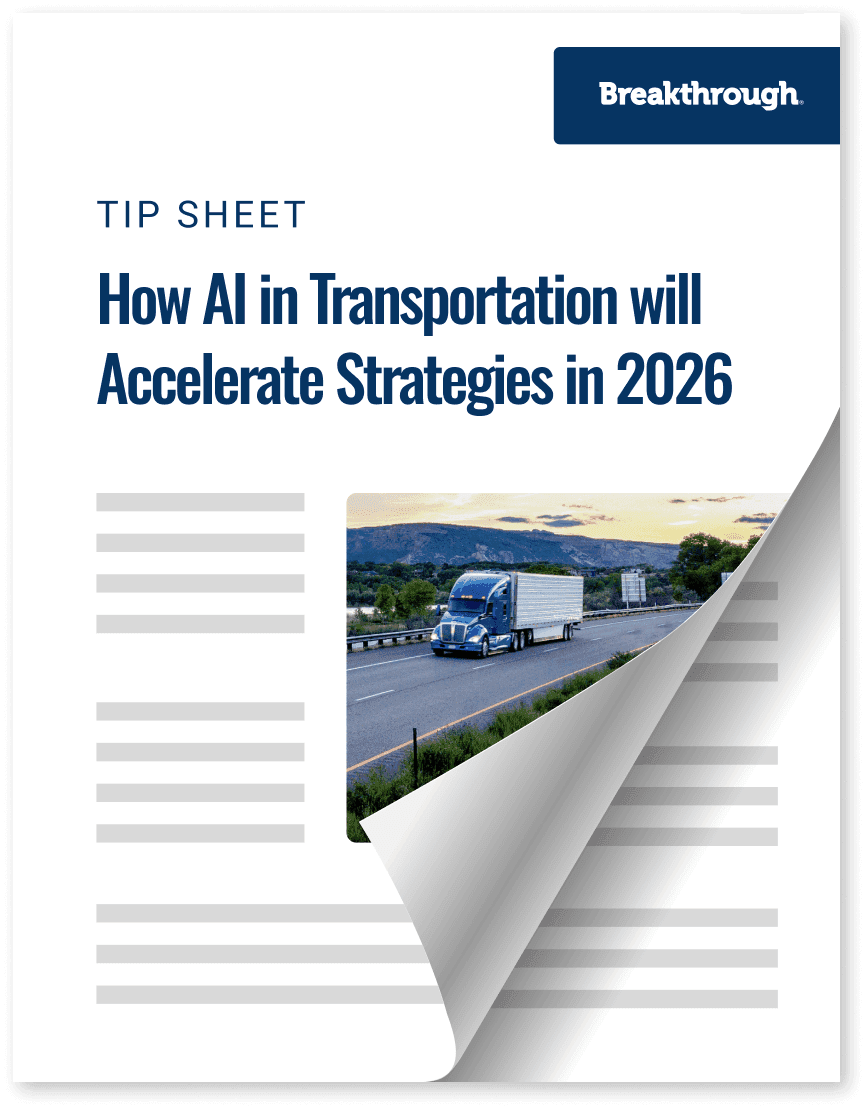How AI in Transportation will Accelerate Strategies in 2026

Trending
Top Posts
Market Events
Understanding the SBTi Corporate Net-Zero Standard V2.0
5 min read
December 16, 2025
Fuel
Why Do Shippers Use The DOE Fuel Surcharge? A History Of The National Fuel Surcharge
5 min read
December 5, 2025
Market Events
How Ukrainian Drone Strikes on Russian Refineries Impact Your Fuel Costs
6 min read
November 20, 2025
8 min read
April 25, 2019

Share:
Table of contents
Browse the table of contents to jump straight to the part you’re looking for
In Q2 2018 we saw record high truck orders in the transportation industry, with orders for class 8 tractors reaching a 10-year peak in August at nearly 45,000 orders. Many shippers wondered if, or hoped that, this influx in trucks on the road would result in expanded capacity—however at the time this impact remained unclear.
As we noted at that time, an increasing number of truck orders does not necessarily lead to an influx in trucks circulating the market or increasing capacity. While the industry has focused on the spike in August 2018, the elevated ordering rate began in October 2017 and continued at this rate for roughly one year. Tractor order backlogs extended out to nearly 11 months, which would have naturally delayed possible downstream fleet expansion until very late 2019 or beyond. Further, a host of unpredictable factors left much of the net impacts of these orders up to speculation.
Read more about our initial analysis of the elevated Class 8 truck orders in our article “Rapid Rises in Truck Orders: What Shippers Need to Know.”
With 2019 well underway, the results of these trends have begun to manifest, and the results favor a more abundant trucking capacity environment in the near-term. What indicators help lead us to this rationalization?
Orders may have trended up, but what will happen to those trucks orders once they are fulfilled? They had the potential to replace older vehicles, grow the overall number of tractors in operation, or achieve both.
The answer? Our tractor population analysis revealed only a slight sequential increase in the tractor population from Q2 to Q3 2018, but a large increase by the end of Q4—thus we can infer that class 8 truck orders both replaced older vehicles and subsequently expanded fleet sizes.

That replacement rate trend did not persist, however, and by Q4 2018, we saw a stark difference in this trend with for-hire VIO surging to a robust 4.0 percent sequential growth rate. A gain of over 30,000 tractors in the overall for-hire tractor population over this same time suggests – holding freight demand on trend – an expansion in capacity. The incremental tractors that were coming online in late 2018 were probably orders in the earlier phase of the order cycle (Jan 2018 – March 2018). This suggests that the orders placed later in the year could add continued capacity into the marketplace throughout the duration of 2019.
As discussed, adding trucks to the market is but one factor to consider related to the trucking capacity environment. The end of 2018 and the start of 2019 experienced year-over-year spot rate declines in all major freight regions of the US.
Referring to our previous conversation about carrier consistency—a metric Breakthrough looks at to determine the rate of carrier compliance over time—we can see that freight contracts are holding to plan incrementally more than in previously tight markets. Carrier consistency is typically expected to decrease over time following a transportation RFP, decreasing by as much as 15 percent over the 45 weeks following a bid event.
In the chart below, we can see that 2019 outbound carrier consistency among Breakthrough client freight is increasing in most major markets. This suggests that carriers are abiding by those previously set carrier contracts more regularly than they are pulling freight to hit the spot market under tight capacity conditions.
We discuss trends we find in our client data related to carrier consistency following a transportation RFP on our blog.

Falling spot rates is one reason carriers may be more inclined to abide by their carrier contracts. Spot market activity usually indicates that more favorable prices are occurring outside of agreed upon rates determined during an RFP—and likely occurred under a different host of economic conditions. As the market shifts into higher demand for trucking capacity, the price shippers are willing to pay increases giving carriers a competitive advantage in the spot market.
When spot rates begin to decline we often see increased compliance toward carrier contracts (and a corresponding increase in carrier consistency), suggesting that capacity is at less of a premium and the supply/demand dynamic is nearing equilibrium.
As mentioned in our prior post, trucking employment is a key consideration in determining available truckload capacity since it takes drivers to haul freight. With an influx in the number of trucks ordered under the assumption that these orders did, indeed, result in an expanded fleet across the industry as discussed previously, the number of drivers needed to meet capacity demands would need to increase. The industry discussed driver shortages widely in 2018, however, this does not appear to hold true into 2019 according to recent studies.
One way to keep a pulse on driver dynamics used by transportation industry professionals is watching the ebb and flow in housing and construction. Because the demographic of truck drivers and construction workers tends to overlap, watching the demand for one often gives a glimpse into the implications of the other. From a driver wage and retention perspective, slowing demand for construction workers can often be a welcome short-term development as a portion of displaced construction workers may choose to turn to trucking to maintain a relatively higher wage.

While the previously mentioned indicators relate directly to the truck ordering environment, it should not be overlooked that the overall state of the economy plays just as large a role in determining the future of freight capacity. While many factors are at play at any given time, several key indicators to take note of as they relate to trucking capacity include the following:
Offsetting weaker consumer spending and in response to the threat of Chinese tariffs and international trade complexities, many businesses ahead of the 2019 ordering cycle. By pulling inventories ahead of the new fiscal year, fourth quarter saw private inventories grow at an accelerated pace—similar to the inventory to build ratios of the trucking industry. As noted above, consumption faltered and was unable to keep pace with inventories which further exacerbated the build-up. As a result, companies are slowing production until a healthier equilibrium can be achieved which ultimately puts downward pressure on shipment volume and capacity demand in the near-term.
The crux of foreign trade as it relates to transportation and supply chain is rooted in one central concept: uncertainty. While trade discussions appear to be progressing with China, murmurs of a trade skirmish with the EU and the ongoing discussion surrounding Brexit leave foreign trade on uncertain footing. While Brexit itself has more muted effects on US trade, the EU is a significant trading partner for Great Britain. Should things go south with that relationship, a large portion of imports and exports could be impacted which could result in lower production and shipping by US businesses.
At the end of 2018, the _rate of growth _in consumer spending declined sharply in response to turmoil in financial markets, the government closing its doors, the housing market stalling and consumer sentiment wavering. This moved consumers off the pace of spending seen earlier in 2018. Moving into 2019, it is expected that overall growth in consumption will be softer than 2018, but still relatively strong as overall employment and wage growth remain robust.
This conversation sparked in response to unconventionally tight capacity conditions that persisted throughout 2018 and came to a head when truck orders spiked. While truck orders are an easy metric to lean on when discussing capacity, it proves to be more convoluted. We can be confident, however, that per previous suspicions, the increase in truck orders seen in Q3 and Q4 of 2018 will be a contributing factor to an easing capacity environment in 2019.
From the shipper perspective, this is an ideal time to secure new rates—particularly in certain geographies and on certain lanes. Among our client base, Breakthrough has already seen many shippers regain some rate advantage in their early 2019 network RFP’s and mini-bids.
Additionally, slowing freight markets provide an opportunity to think strategically about building longer-term carrier relationships. Some shippers are sure to adopt a “spot market opportunism” approach, seeking recover some rate favorability given away during the tight freight market of 2018. Other shippers, however, may choose this time to develop meaningful freight relationships with small-to-mid size carriers – even intentionally growing them. Doing so now when the market is in flux could mean better long-term relationships for when the next freight crunch inevitably hits.
Breakthrough believes that cultivating partnerships among stakeholders is the most transparent, fair, and accurate way to mitigate the drastic effects of the supply/demand pendulum.
For more information about the freight market, truck orders, or developing positive carrier relationships, contact us.

5 min read
December 16, 2025
Explore the draft V2.0 SBTi corporate net-zero standard. Learn about new guidance on biofuels, EACs, and scope 1 and 3 emissions to reach net-zero by 2050.
Read more
5 min read
December 5, 2025
The DOE fuel surcharge is an outdated, inaccurate method for fuel reimbursement. Learn why it costs you money and discover a modern, market-based alternative.
Read more
6 min read
November 20, 2025
Understand the impact of Ukrainian drone strikes on Russian refineries. Learn why diesel prices are volatile and how to protect your budget from market shocks.
Read more